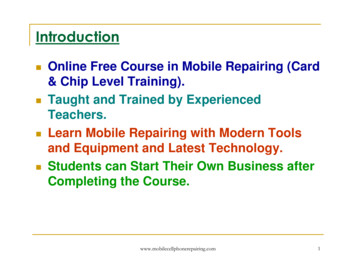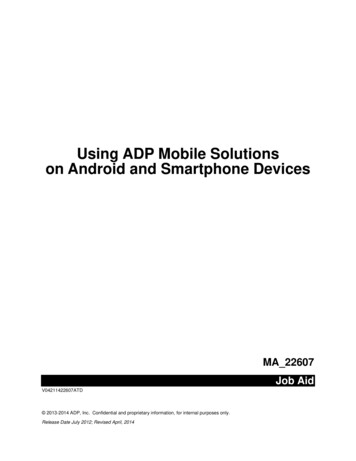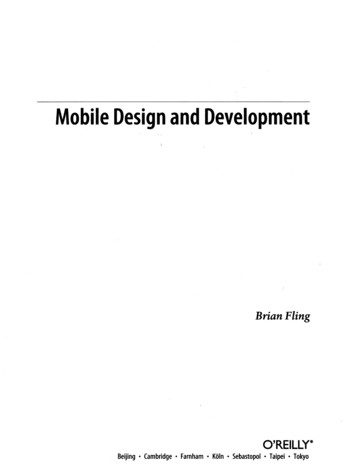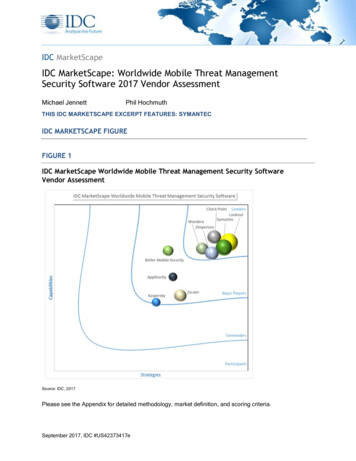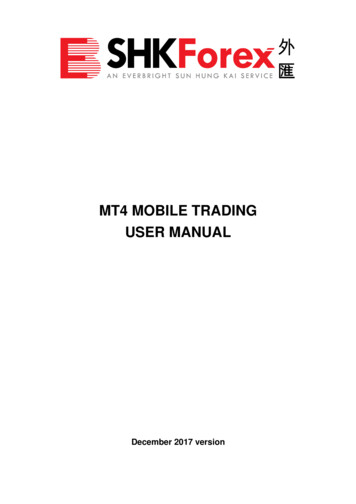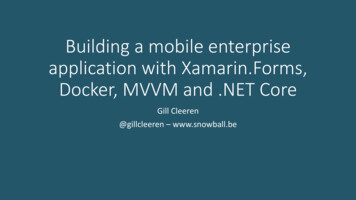
Transcription
Building a mobile enterpriseapplication with Xamarin.Forms,Docker, MVVM and .NET CoreGill Cleeren@gillcleeren – www.snowball.be
Agenda Overall application structure The Xamarin application architecture MVVMDependency InjectionLoose-coupled MessagingNavigationService communicationTesting Backend architecture .NET Core-based Microservices Docker
The Solution Structure
Client appsBackend in Docker hostMicroservice 1Product catalogXamarin.Formsmobile appHTML webfront-endSPAMVC appMicroservice 2OrderingMicroservice 3Identity
DEMOLooking at the Solution Structure & the Finished Application
The Xamarin applicationarchitecture
MVVM
MVVM Architectural pattern Based on data binding andcommanding Popular for testable andmaintainable XAML applications
What we all did when we were young Write code in code-behind Lots of it.ViewXAMLCode-BehindEvent HandlersData Model
Writing testable code however, is becomingthe norm. Finally. Courtesy of MVVM.ViewXAMLCode-BehindData-bindingand commandsChangenotificationView ModelState OperationsData Model
Benefits of MVVM Testable Developers and designers canwork independently A new XAML view can be addedon top of the view models withoutproblems Changes can be made in viewmodel without risking issues withthe model
Sample View Code Entry Text "{Binding UserName.Value, Mode TwoWay}" /Entry LabelText "{Binding UserName.Errors,Converter {StaticResource FirstValidationErrorConverter}" / ListViewIsVisible "{Binding Campaigns.Count, Converter {StaticResourceCountToBoolConverter}}"ItemsSource "{Binding Campaigns}"
Sample View Model Codepublic class LoginViewModel : INotifyPropertyChanged{public string UserName{ get; set; }public string Password{ get; set; }public ICommand SignInCommand new Command(async () await SignInAsync());}
DEMOThe MVVM Pattern Applied
Responding to changes in the (view) model Handled through INotifyPropertyChanged interface PropertyChanged raised for changes of view model or model propertyvalue changes (View)Model property changesCalculated propertiesRaise event at the end of a method that makes changes to the property valueDon’t raise PropertyChanged when the value didn’t changeDon’t raise PropertyChanged from the constructorDon’t raise PropertyChanged in a loop
BindableObjectpublic abstract class ExtendedBindableObject : BindableObject{public void RaisePropertyChanged T (Expression Func T property){var name e);}private MemberInfo GetMemberInfo(Expression expression){.}}
DEMOLooking at the ViewModels
Commanding Action is defined in one place andcan be called from multiple placesin the UI Available through ICommandinterface Defines Execute() andCanExecute() Can create our own or use built-incommands
The ICommand Interfacepublic interface ICommand{event EventHandler CanExecuteChanged;bool CanExecute(object parameter);void Execute(object parameter);}
Behaviors Command property available onlyon ButtonBase-derived controls Other controls and interactionsonly possible through“behaviours” Use of an attached behaviour Use of a Xamarin.Formsbehaviour
EventToCommandBehaviorpublic class EventToCommandBehavior : BindableBehavior View {protected override void OnAttachedTo(View visualElement){ . }}
Using EventToCommandBehavior ListViewItemsSource "{Binding Orders}" ListView.Behaviors behaviors:EventToCommandBehaviorEventName "ItemTapped"Command "{Binding OrderDetailCommand}"EventArgsConverter "{StaticResource ItemTappedEventArgsConverter}" / /ListView.Behaviors /ListView
Using TapGestureRecognizer StackLayout Label Text "SETTINGS"/ StackLayout.GestureRecognizers TapGestureRecognizerCommand "{Binding SettingsCommand}"NumberOfTapsRequired "1" / /StackLayout.GestureRecognizers /StackLayout
DEMOCommanding Done Right
Who Knows Who?ViewView ModelModel
Linking the View and the View ModelView-FirstView Model-First
View-First (from XAML) ContentPage ContentPage.BindingContext local:LoginViewModel/ /ContentPage.BindingContext /ContentPage
View First (from code)public LoginView(){InitializeComponent();BindingContext new LoginViewModel();}
The View Model LocatorViewModel 1View 1View 2View nViewModelLocatorViewModel 2ViewModel n
DEMOThe ViewModel Locator
Dependency Injection
Dependency Injection Type of inversion of control (IoC) Another class is responsible forobtaining the requireddependency Results in more loose coupling Container handles instantiationas well as lifetime of objects Autofac is commonly used Many others exist
Dependency derService
DEMOWorking with Dependency Injection
Loose-coupled Messaging
View Model communicationView ModelView ModelView ModelView ModelView ModelView ModelView ModelView Model
Messaging Center built-in in iew ModelView ModelState OperationsData ModelState OperationsData ModelMessagePublishmessagesViewXAMLSubscribe tomessagesMessaging CenterMessage(XF)CodeBehindView ModelState Operations
Messaging Center Implements pub-sub model for usalready Built-in in Xamarin.Forms Multicast supported Based on strings (not alwaysperfect)
DEMOWorking with Messages and the Messaging Center
Navigation
Navigation and MVVM Navigation isn’t always easy toinclude in an MVVM scenario No tight-coupling can beintroduced Who is responsible fornavigation? View Model?View? How can we pass parametersduring navigation? Xamarin.Forms comes withINavigation interface Will be wrapped as it’s toobasic for real-life scenarios
Our Own NavigationService Must be registered in the Dependency Injection systempublic interface INavigationService{ViewModelBase PreviousPageViewModel { get; }Task InitializeAsync();Task NavigateToAsync TViewModel () where TViewModel : ViewModelBase;Task NavigateToAsync TViewModel (object parameter) where TViewModel : ViewModelBase;Task RemoveLastFromBackStackAsync();Task RemoveBackStackAsync();}
DEMOAdding Navigation
Service communication
Take some REST REST: Representational State Transfer Based on open HTTP standards Open for all types of applications Works with Resources We’ll send requests to accessthese resources URI and HTTP method are usedfor this Results in HTTP Status code 200, 404 based on result ofrequest
Communicating with a REST API Apps will typically use services for making the data request Are responsible for communication with the actual API Controllers on API microservices return DTOs Are transferred to the application App can use HttpClient class Works with JSON Returns HttpResponseMessage after receiving a request Can then be read and parsed Json.NET
Loading data from the servicepublic override async Task InitializeAsync(object navigationData){IsBusy true;Products await productsService.GetCatalogAsync();Brands await productsService.GetCatalogBrandAsync();Types await productsService.GetCatalogTypeAsync();IsBusy false;}
DEMOAccessing Remote Data
Backend architecture
ASP.NET Core
.NET Core“.NET Core is a general purpose development platform maintained byMicrosoft and the .NET community on GitHub. It is cross-platform,supporting Windows, macOS and Linux, and can be used in device,cloud, and embedded/IoT scenarios.”source: ore
ASP.NET Core“ASP.NET Core is a new open-source and cross-platform framework forbuilding modern cloud based internet connected applications, such asweb apps, IoT apps and mobile backends.”source: https://docs.microsoft.com/en-us/aspnet/core
ASP.NET Core Built on top of .NET Core Lightweight Cross-platform Windows, Mac & Linux Easy in combination with Docker and Microservices
Containerized Microservices
Monoliths Client-server often results intiered applications Specific technology used pertier Known as monolithicapplications Often have tight couplingbetween components in each tier Components can’t be scaledeasily Testing individual componentsmight also be hard
Monoliths Not being able to scale can beissue for cloud readiness All layers typically are required Scaling is cloning the entireapplication onto multiplemachines
Monolithic applications
Enter microservices Microservices are easier for deployment and development Better agility Better combination with cloud App will be decomposed into several components Components together deliver app functionality Microservice small app, independent concern Have contracts to communicate with other services Typical microservices Shopping cart Payment system Inventory system
Enter microservices Can scale out independently If an area requires more processing power, can be scaled out separately Other parts can remain the same Scale-out can be instantaneous Web front-end for handling moreincoming traffic
Enter microservices Microservices manage their own data Locally on the server on which they run Avoid network overhead Faster for processing Even eliminate need for caching Support for independent updates Faster evolution Rolling updates, onto subset of instances of single service support rollback
Benefits of usingmicroservicesSmallEvolve easilyScale-out independentlyIsolate issues to the faultymicroservice Can use latest and greatest Not constrained to using oldertechnologies
Disadvantages ofmicroservices Partitioning a real application is hard Complex Intercommunication betweenservices Eventual consistency Atomic transactions often notsupported Deployment (initial) might be harder Direct client-to-microservicecommunication might not be a goodidea
DEMOLooking at the Microservices
“Containerization is an approach to software development inwhich an application and its versioned set of dependencies,plus its environment configuration abstracted as deploymentmanifest files, are packaged together as a container image,tested as a unit, and deployed to a host operating system”
Adding containers to themix Container is isolated, resourcecontrolled and portable operatingenvironment Applications in containers runwithout touching resources ofhost or other containers Acts like a VM or physicalmachine Work great in combination withmicroservices Docker is most commonly usedapproach here
What’s a container really? Container runs an operating system Contains file system Can be accessed over the network like a real machine/VM Contain the application (and dependencies) In general, require less resources to run than regular VMs Allow for easy and fast scale-up by adding new containers
Adding containers to the mix
Using Docker to host the microservices Each container hosts a separatepart of the applicationMicroservice 1Product catalog Single area of functionality Each microservice has its own database Allows for full decoupling Consistency is eventual Can be improved using application eventsMicroservice 2Ordering Service busMicroservice 3Identity
DEMOContainerization
Summary MVVM is the go-to standard for building enterprise-levelXamarin.Forms apps .NET Core is a good choice for building microservices Docker helps with deployment of microservices
Thanks!
Building a mobile enterpriseapplication with Xamarin.Forms,Docker, MVVM and .NET CoreGill Cleeren@gillcleeren – www.snowball.be
.NET Core-based Microservices Docker. The Solution Structure. Client apps Backend in Docker host Xamarin.Forms mobile app HTML web front-end SPA Microservice 1 . .NET Core is a good choice for building microservices Docker helps with deployment of microservices. Thanks! Building a mobile enterprise application with Xamarin.Forms .

